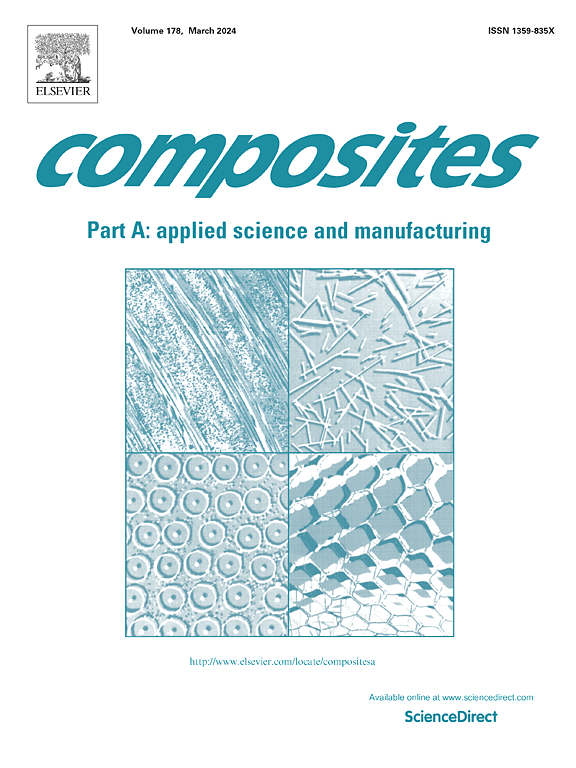分子间氢键使机械坚固,热稳定,耐溶剂的生物基聚酰亚胺网络
IF 8.1
2区 材料科学
Q1 ENGINEERING, MANUFACTURING
Composites Part A: Applied Science and Manufacturing
Pub Date : 2025-05-03
DOI:10.1016/j.compositesa.2025.109006
引用次数: 0
摘要
随着人们环保意识和可持续发展理念的增强,共价自适应网络因其智能化和可持续性而受到越来越多的关注。然而,它们仍然面临着挑战,包括如何平衡综合性能,动态特性和高可燃性。本文以木质素衍生的香兰素为前驱体,合成了具有优异综合性能和一定防火性能的生物基聚亚胺(TMP-IPDA-Si)。分子动力学模拟表明,酰腙结构的引入和酰基腙键的形成增强了聚合物网络之间的分子间氢键相互作用,使得聚酰亚胺材料具有优异的力学性能(抗拉强度为85.7 MPa)和高Tg(201.4℃)。TMP-IPDA-Si表现出优异的耐溶剂性,在水溶液中放置72 h后,其机械性能保持90%以上。它还表现出出色的热稳定性和高炭收率(超过46%),超过了许多先前报道的聚酰亚胺。在MCC试验中,TMP-IPDA-Si显示较低的THR (8.5 kJ g−1)和PHRR (170.5 W g−1)值。该研究为设计具有优异力学性能和高Tg的生物基聚酰亚胺奠定了科学基础,在防火安全和可持续材料方面具有更广泛的应用潜力。本文章由计算机程序翻译,如有差异,请以英文原文为准。
Intermolecular hydrogen bonding enabling mechanically robust, thermally stable, and solvent-resistance bio-based polyimine networks
With the increasing awareness of environmental protection and the concept of sustainable development, covalent adaptable networks are receiving growing attention due to their intelligent functionalities and sustainability. However, they still face challenges, including how to balance comprehensive performance, dynamic features and high flammability. Herein, lignin-derived vanillin was used as a precursor to synthesize the bio-based polyimine (TMP-IPDA-Si) with excellent comprehensive performance and certain fire safety properties. The molecular dynamics simulations showed that the introduction of hydrazide structures and the formed acylhydrazone bonds enhanced the intermolecular hydrogen bonding interactions between the polymer networks, resulting in polyimine materials with outstanding mechanical properties (tensile strength of 85.7 MPa) and high Tg (201.4 °C). The TMP-IPDA-Si exhibited excellent solvent resistance, retaining over 90 % of its mechanical properties after 72 h in aqueous solutions. It also showed outstanding thermal stability and high char yield (over 46 %), surpassing many previously reported polyimine. In MCC tests, the TMP-IPDA-Si displayed low THR (8.5 kJ g−1) and PHRR (170.5 W g−1) value. This study lays the scientific groundwork for designing bio-based polyimines with superior mechanical properties and high Tg, offering potential for broader applications in fire-safe and sustainable materials.
求助全文
通过发布文献求助,成功后即可免费获取论文全文。
去求助
来源期刊

Composites Part A: Applied Science and Manufacturing
工程技术-材料科学:复合
CiteScore
15.20
自引率
5.70%
发文量
492
审稿时长
30 days
期刊介绍:
Composites Part A: Applied Science and Manufacturing is a comprehensive journal that publishes original research papers, review articles, case studies, short communications, and letters covering various aspects of composite materials science and technology. This includes fibrous and particulate reinforcements in polymeric, metallic, and ceramic matrices, as well as 'natural' composites like wood and biological materials. The journal addresses topics such as properties, design, and manufacture of reinforcing fibers and particles, novel architectures and concepts, multifunctional composites, advancements in fabrication and processing, manufacturing science, process modeling, experimental mechanics, microstructural characterization, interfaces, prediction and measurement of mechanical, physical, and chemical behavior, and performance in service. Additionally, articles on economic and commercial aspects, design, and case studies are welcomed. All submissions undergo rigorous peer review to ensure they contribute significantly and innovatively, maintaining high standards for content and presentation. The editorial team aims to expedite the review process for prompt publication.
 求助内容:
求助内容: 应助结果提醒方式:
应助结果提醒方式:


